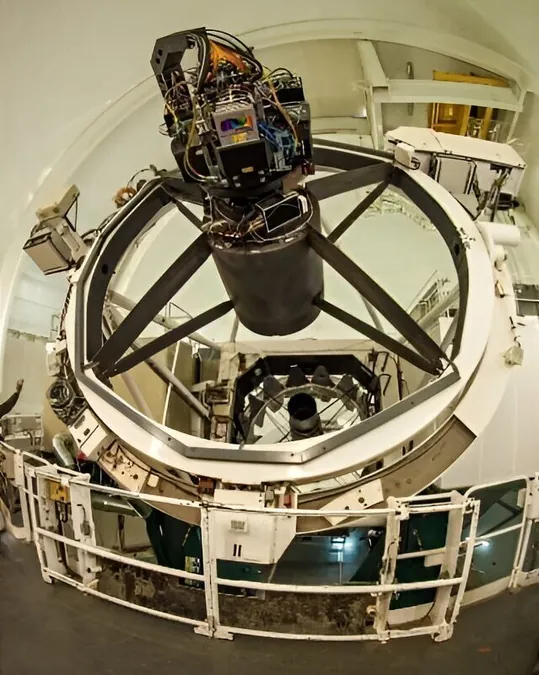
Groundbreaking Discovery: Exact Locations of Over 1 Million Galaxies Exposed!
2024-09-28
Introduction
In a monumental stride for astronomy, the Physics of the Accelerating Universe Survey (PAUS) — a collaborative effort spanning 14 institutions — has unveiled precise locations of over 1 million galaxies, covering a sky area equivalent to about 250 full moons. This ambitious survey utilized the cutting-edge PAUCam camera on the 4.2-meter William Herschel Telescope (WHT) situated in La Palma, Spain, achieving astonishing measurements for galaxies more than 10 billion light-years away!
Survey Methodology
PAUS employs a unique hybrid method that cleverly combines photometric and spectroscopic techniques. Photometric surveys capture vivid images of the cosmos, identifying all the visible objects, while spectroscopic surveys analyze the light spectrum of known sources for detailed information. PAUS enhances this approach by utilizing 40 narrow wavelength filters, allowing astronomers to recreate a low-resolution spectrum for each galaxy, which significantly improves the quality of the data collected.
Expert Insights
Professor Benjamin Joachimi from UCL Department of Physics & Astronomy, emphasized the significance of this method, stating, "By discerning the light from specific parts of the spectrum, we achieve unparalleled accuracy in measuring the distances of galaxies. This revolutionary survey will deepen our comprehension of how galaxies interact with their dark matter-dominated environments and will aid in refining other astronomical surveys."
Implications of the Findings
The implications of this catalogue are immense; it will facilitate the creation of comprehensive maps that elucidate the formation of cosmic structures and comprehend the universe's expansion influenced by dark matter and dark energy. Dark energy, which is believed to make up around 70% of the universe, is attributed to the mysterious accelerating expansion of the cosmos, leaving scientists eager to uncover its enigma.
Data Collection and Accessibility
Led by the Institute of Space Sciences (ICE-CSIC) and backed by Spain’s Ministry of Science, Innovation, and Universities, this groundbreaking data was collected over 200 nights between 2015 and 2019. The full catalogue, which promises to reshape our understanding of the universe, is accessible via the PAUS website and the CosmoHub web portal.
Collaborative Achievements
Professor Enrique Gaztañaga, Director of the PAU Survey, expressed pride in the collaborative effort: "This innovative approach to cosmic mapping, fueled by a novel instrument and dedicated survey methodology, has opened new avenues for astronomical research. Collaborating with such a talented team has been a great honor."
Further Reading
Further details regarding the catalogue's release are documented in two pivotal articles. One on the calibration of PAUS data has been published in the *Monthly Notices of the Royal Astronomical Society*, while the other, focusing on measuring distances, is slated for publication in MNRAS and is available on the arXiv preprint server.
Critical Contributions
Ph.D. student David Navarro-Gironés, the prime author of the arXiv paper, highlighted the critical nature of this work: "The precision of 0.3% in measuring the distances of distant galaxies is a game changer. This accuracy is essential for studying cosmic structures and enhances the calibration of existing cosmological surveys."
Conclusion
As we enter an exciting era of cosmic discovery, researchers are readying to capitalize on this data to deepen our understanding of the universe's fabric and its mysterious forces. Stay tuned for more revelations from the cosmos!


 Brasil (PT)
Brasil (PT)
 Canada (EN)
Canada (EN)
 Chile (ES)
Chile (ES)
 España (ES)
España (ES)
 France (FR)
France (FR)
 Hong Kong (EN)
Hong Kong (EN)
 Italia (IT)
Italia (IT)
 日本 (JA)
日本 (JA)
 Magyarország (HU)
Magyarország (HU)
 Norge (NO)
Norge (NO)
 Polska (PL)
Polska (PL)
 Schweiz (DE)
Schweiz (DE)
 Singapore (EN)
Singapore (EN)
 Sverige (SV)
Sverige (SV)
 Suomi (FI)
Suomi (FI)
 Türkiye (TR)
Türkiye (TR)